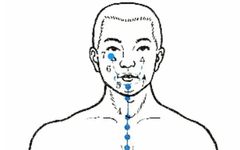
What are the Eight Extraordinary Meridians?
The Eight Extraordinary Meridians (qí jīng bā mài), where “qí” means extraordinary, refer to the eight meridians outside of the twelve primary meridians (zhèng jīng). They do not directly connect to the organs (zàng fǔ) and have no interior-exterior relationship, hence they are termed “extraordinary meridians”.
These include the Ren Mai (Ren Meridian), Du Mai (Governing Meridian), Chong Mai (Penetrating Meridian), Dai Mai (Belt Meridian), Yin Qiao Mai (Yin Heel Meridian), Yang Qiao Mai (Yang Heel Meridian), Yin Wei Mai (Yin Linking Meridian), and Yang Wei Mai (Yang Linking Meridian).
Physiological Characteristics of the Eight Extraordinary Meridians
The physiological characteristics of the Eight Extraordinary Meridians can be summarized in three points:
① The Eight Extraordinary Meridians have no direct connection to the organs;
② There is no interior-exterior relationship among the Eight Extraordinary Meridians;
③ The distribution of the Eight Extraordinary Meridians is not as widespread as that of the twelve primary meridians; there are no distributions of the Eight Extraordinary Meridians in the upper limbs. Their pathways also differ from the twelve primary meridians, as all except the Dai Mai ascend from below.
Common Physiological Functions
What are the common physiological functions of the Eight Extraordinary Meridians?
1. They further strengthen the connections between the twelve primary meridians.
For example, the Du Mai governs all Yang meridians; the Ren Mai governs all Yin meridians; the Dai Mai restrains the longitudinal meridians. The two Qiao meridians govern the Yin and Yang of the body; the two Wei meridians connect the Yin and Yang of the body. Thus, the Eight Extraordinary Meridians enhance the connections among various parts of the body.
2. They regulate the Qi and blood of the twelve primary meridians.
When the Qi of the twelve primary meridians is excessive, it is stored in the Eight Extraordinary Meridians; when the Qi and blood of the twelve primary meridians are insufficient, the Eight Extraordinary Meridians can “overflow” to provide timely supplementation.
3. The Eight Extraordinary Meridians have a close relationship with the liver, kidneys, and other organs, as well as with the uterus, brain, and marrow, indicating a significant physiological and pathological connection among them.
Pathways of the Eight Extraordinary Meridians
Ren Mai
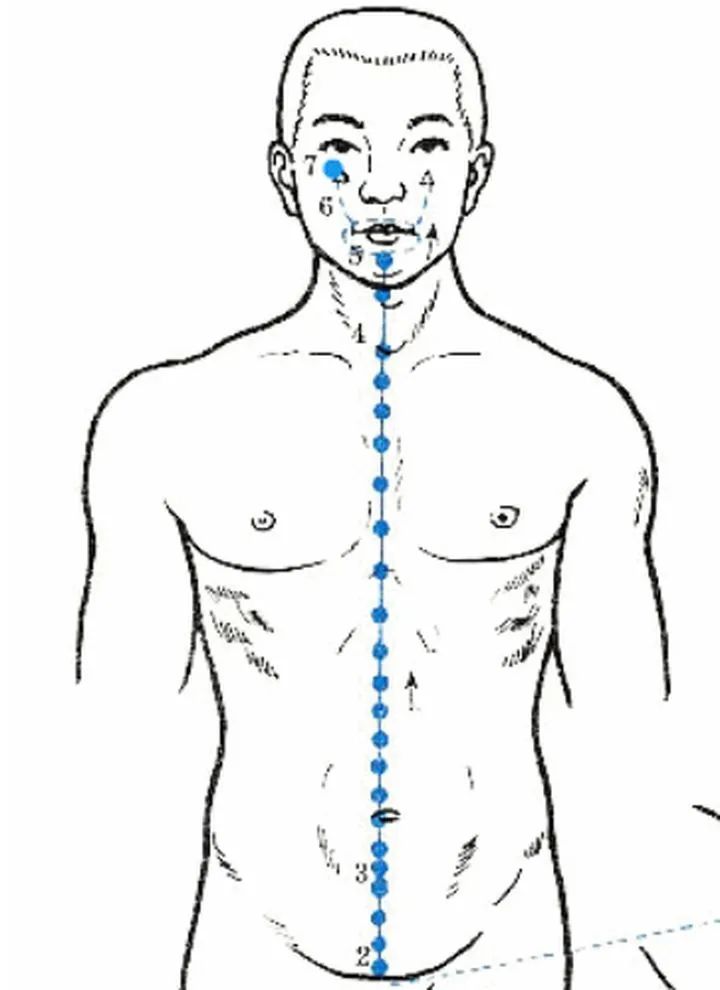
1. Pathway
The Ren Mai originates in the lower abdomen, exits at the perineum, ascends along the midline of the abdomen, passes through the throat (Tiāntū point), reaches the lower lip, divides to encircle the lips, and meets at the Yinjiao point of the Du Mai, then ascends to the lower eye socket (Chéngqì point), connecting with the Yangming meridian of the foot.
2. Branches
It traverses from the lower abdomen to the back.
- Physiological Functions
(1) Regulates the Qi and blood of the Yin meridians, as the Ren Mai circulates along the midline of the abdomen, which is Yin, indicating its role in overseeing and regulating the Qi of all Yin meridians. Additionally, the three Yin meridians of the foot intersect with the Ren Mai, thus it has a regulatory effect on the Qi and blood of the Yin meridians, hence the saying “oversees all Yin”.
(2) Regulates menstruation and supports pregnancy. The Ren Mai originates in the lower abdomen, playing a role in regulating menstruation and promoting female reproductive functions, hence the saying “Ren governs the uterus”.
Du Mai
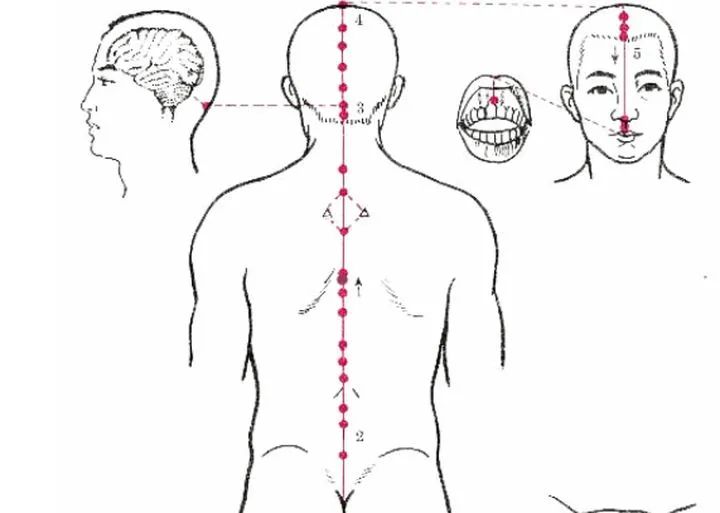
1. Pathway
The Du Mai originates in the lower abdomen, exits at the perineum, travels to the tailbone (Chángqiáng point), ascends along the spine, passes through the nape to the Fengfu point, enters the brain, belongs to the brain, ascends along the midline of the head to the Baihui point, descends through the forehead to the tip of the nose (Sùliáo point), passes through the philtrum, and reaches the Yinjiao point of the upper teeth.
2. Branches
The first branch, along with the Chong and Ren meridians, originates in the lower abdomen, exits at the perineum, and meets the Kidney and Bladder meridians at the tailbone, connecting to the kidneys. The second branch ascends directly from the lower abdomen through the navel, reaches the heart, and meets the Chong and Ren meridians at the throat, then travels to the jaw, encircles the lips, and reaches the center below the eyes. The third branch, originating from the inner corner of the eye, ascends to the forehead, meets at the top of the head, connects to the brain, and then descends along the back of the neck, along the muscles beside the spine, reaching the waist and entering the muscles on both sides of the spine, connecting to the kidneys.
3. Physiological Functions
(1) Regulates the Qi and blood of the Yang meridians, as the Du Mai circulates along the back, which is Yang, indicating its role in overseeing and regulating the Qi of all Yang meridians. Additionally, all six Yang meridians meet at the Dàzhuī point, showing the Du Mai’s regulatory effect on Yang meridians, hence the saying “governs all Yang meridians”.
(2) Reflects the functions of the brain, kidneys, and spinal cord. The Du Mai belongs to the brain and connects to the kidneys. The kidneys produce marrow, and the brain is the sea of marrow, indicating a close relationship among the Du Mai, brain, kidneys, and spinal cord.
(3) Governs reproductive functions. The Du Mai connects to the kidneys, which govern reproduction, thus it is related to reproductive functions.
Chong Mai
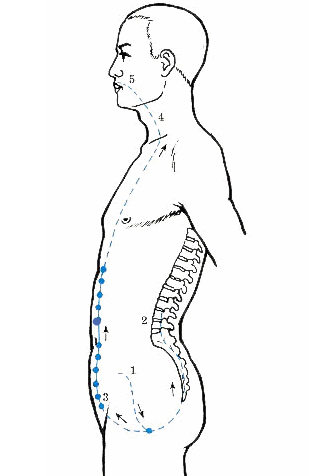
1. Pathway
The Chong Mai originates in the uterus, exits at the perineum, and divides into two branches. The ascending branch (the main part of the Chong Mai) travels along the anterior abdominal wall near the navel (five fen beside the navel), connects with the foot Shaoyin meridian, spreads in the chest, ascends through the throat, and encircles the lips; the descending branch travels down from the perineum along the inner thigh to the space between the big toe.
2. Physiological Functions
(1) Regulates the Qi and blood of the twelve meridians. The Chong Mai ascends to the head and descends to the feet, traversing the entire body, serving as a crucial point for overseeing the Qi and blood of all meridians. When the Qi and blood of the meridians and organs are excessive, the Chong Mai can store and reserve it; when they are insufficient, the Chong Mai can provide infusion and supplementation to maintain the normal physiological activities of various tissues and organs. Thus, it is known as the “sea of the twelve meridians”, “sea of the five organs and six bowels”, and “sea of blood”.
(2) Governs reproductive functions. The Chong Mai originates in the uterus, also known as the “blood chamber” or “sea of blood”. It plays a role in regulating menstruation. The Chong Mai is closely related to reproductive functions; for women, “when the Chong Mai is abundant, menstruation occurs regularly, hence the saying ‘when the Chong Mai is weak, menstruation is obstructed'”. This refers to the Chong Mai. Additionally, for men, either congenital deficiency of the Chong Mai or acquired injury can lead to reproductive dysfunction.
(3) Regulates the ascending and descending of Qi. The Chong Mai connects with the foot Shaoyin, belongs to the Yangming, and connects to the Jueyin and Taiyang. It has the function of regulating the ascending and descending of Qi in certain organs (mainly the liver, kidneys, and stomach).
Dai Mai
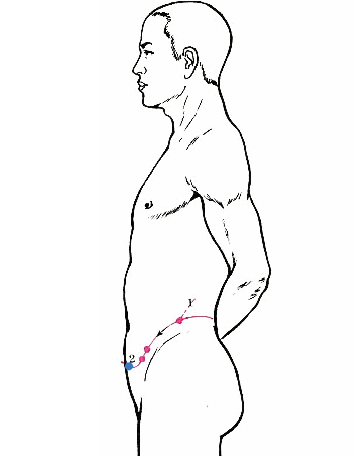
1. Pathway
The Dai Mai originates in the lateral costal region, descends obliquely, meets at the Dai Mai point of the foot Shaoyang gallbladder meridian, encircles the body, and then descends obliquely along the upper edge of the hip bone to the lower abdomen.
2. Physiological Functions
It restrains the longitudinal meridians and governs women’s leukorrhea.
Yin Qiao Mai
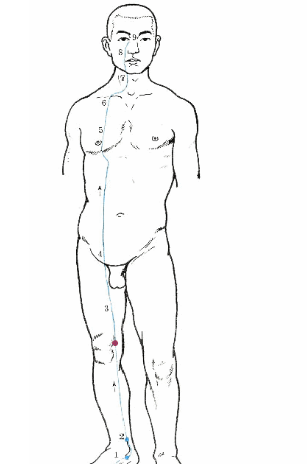
1. Pathway
The Yin Qiao Mai originates at the inner side of the heel of the foot (Zhaohai point), ascends through the inner ankle, along the inner thigh to the anterior genital area, ascends along the anterior surface of the trunk to the chest, reaches the throat beside the Adam’s apple, and ascends to the side of the nose, connecting with the inner corner of the eye, and meets with the Yang Qiao and Taiyang meridians.
2. Physiological Functions
It controls the opening and closing of the eyes and the movement of the muscles.
Yang Qiao Mai
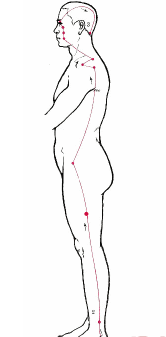
1. Pathway
The Yang Qiao Mai originates at the outer side of the heel of the foot (Shenmai point), ascends along the outer ankle, travels up the outer edge of the lower limb to the abdomen, along the posterior outer side of the chest, through the shoulder, neck, and reaches the corner of the mouth, ascending to the inner corner of the eye. It connects with the Yangming and Yin Qiao meridians, then ascends along the Yangming meridian to meet at the Fengchi point behind the neck.
2. Physiological Functions
It controls the opening and closing of the eyes and the movement of the muscles.
Yin Wei Mai
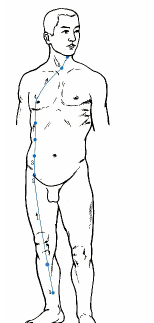
1. Pathway
The Yin Wei Mai originates five cun above the inner ankle (Zhùbīn point), ascends along the inner edge of the lower limb, reaches the abdomen, travels alongside the foot Taiyin spleen meridian to the lateral costal region, connects with the foot Jueyin liver meridian, ascends to meet at the Tiāntū point of the Ren Mai, and terminates at the Lianquan point beside the throat.
2. Physiological Functions
The term “Wei” in Yin Wei means to connect and link. The Yin Wei has the function of linking the Yin meridians.
Yang Wei Mai
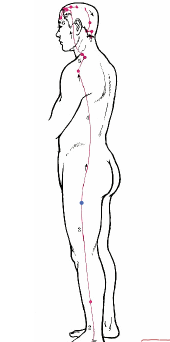
1. Pathway
The Yang Wei Mai originates at the Jinmen point of the foot Taiyang, passes over the outer ankle, ascends along the outer edge of the lower limb, travels along the posterior outer side of the trunk, from the back of the armpit to the shoulder, ascends through the neck, behind the ear, and reaches the forehead, distributing along the side of the head and back of the neck, connecting with the Du Mai.
2. Physiological Functions
It links the Yang meridians.
If you find this useful, please click 'like' below.
